Contents
Market Overview
Macro Review
The week ended with an aggressive interest rate rally. A collection of weak Eurozone PMIs on Friday saw German bunds rally almost 20bps with peripheral sovereigns some 30bps tighter. In fact, the 2-year German note tightened 28bps at one stage to 0.36%, which is the largest one-day move since 2008. What is striking is that the 2-year note almost hit 0.80% after the ECB tightened rates by 50bps on Thursday, while keeping the door open to peripheral support via the “Transmission Protection Instrument”. The “TPI” remains a rather vague tool that was introduced into the ECB’s armoury, but it ought to cap Italian 10-year “Club Med” yields at 250-275bps over German bunds. The strength in Eurozone rates spread globally and took the 10-year US Treasury to a two-month low of 2.72% on Friday. Elsewhere, South Africa hiked policy rates by 75bps as inflation is beginning to gyrate through the economy with ZAR rallying on the SARB’s credibility (expectations were only 50bps). However, credibility is waning in Indonesia as the BI kept rates unchanged at 3.5% and remains the only other key Asian central bank to hold rates unchanged, along with Thailand. Ukraine also announced its intentions to defer interest and principal payments over a two-year period. Ukraine’s Ministry of Finance sought to maintain some optionality with the ability to redeem its Eurobond debt, but cede that their ability to remain current has severely deteriorated amid the five-month conflict. The National Bank of Ukraine subsequently allowed the hryvnia to devalue by 25%, which is the second-largest move in its history since 1996. Ukraine’s quasi-sovereign issuers, such as Ukrainian Railways and the Export-Import Bank of Ukraine, have kept up with coupon payments, but both Ukravtodor (public road agency) and Ukrenergo (utility) have sought to follow the sovereign. Naftogaz is seeking a more aggressive form of standstill agreement without a consent fee or aggregation of unpaid accrued interest on its debt, which seems unlikely to receive creditor approval and therefore is likely to be first Ukrainian entity to enter a more challenging technical default. Importantly, there remains a viable path for quasi-sovereigns to remain current, even if the sovereign defaults. A second example we had this week was with Sri Lankan Airlines which paid the coupon on its 2024 notes, which is also an explicit government guaranteed bond structure. In keeping with potential defaults, Ghana’s finance ministry accidently stated that gross reserves had dipped to $3bn, before clarifying that gross reserves had only dipped from $8.1bn in May to $7.6bn in June and the $3bn reference was in relation to net reserves. This spooked the market, where the risk of default rose substantially.
EM Credit Update
Emerging market sovereign credit ended the week up 2.2% with spreads 31bps tighter. Outperformers over the week were El Salvador, Sri Lanka and Zambia, while Ukraine, Argentina and Pakistan underperformed.
The Week Ahead
The key feature next week is the FOMC decision on Wednesday. The weekend debate as to whether monetary policy is tightened 50bps, 75bps or even 100bps will of course ensue, especially after an out-sized ECB hike of 50bps. This will fall before European inflation and GDP prints, just as the EU is set to vote on cutting gas by 15%. These events also fall just as the IMF is expected to update its world economic outlook. EM interest rate decisions are coming up with Colombia (7.5%), Ghana (19.0%), Hungary (9.75%), Kazakhstan (14.0%) and Kenya (7.5%). Inflation is then due out of Poland, although we are already aware that the NBP forecasts core CPI to peak in 4Q22 and headline to peak in 1Q23. Amidst these events, earnings are due from Alphabet, Apple, Amazon, Microsoft and Meta, among others.
Highlights from emerging markets discussed below include: Sri Lanka’s parliament elects ousted ex-President Rajapaksa’s ally to replace him; Pakistan rating outlook moved to negative by Fitch; Khan calling for early elections amid strong election results in Punjab; South Africa rate hike surprises to the upside; Mexico and Pemex ratings unsurprisingly lowered one notch by Moody’s
Fixed Income
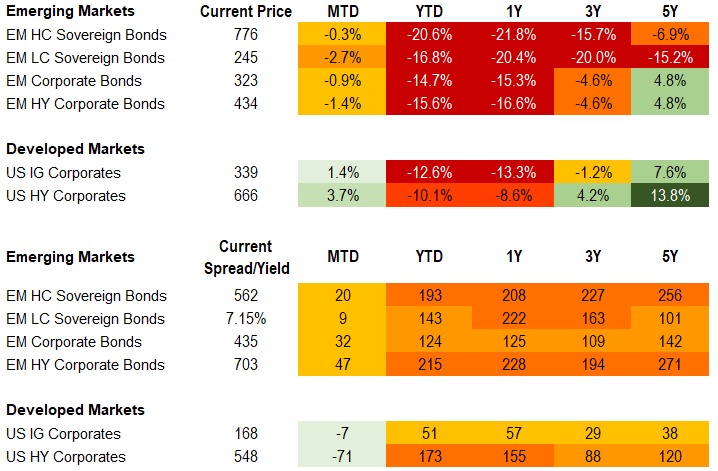
Equities
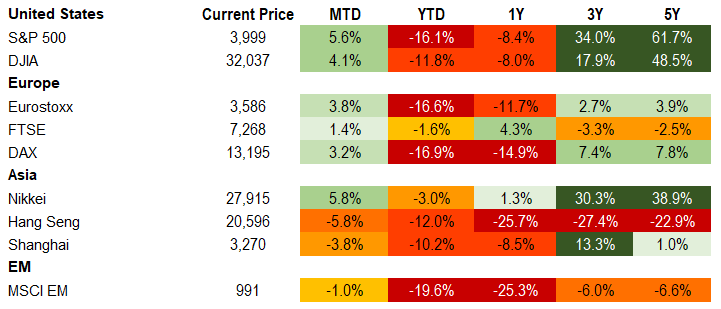
Commodities

Source for data tables: Bloomberg, JPMorgan, Gramercy. EM Fixed Income is represented by the following JPMorgan Indicies: EMBI Global, GBI-EM Global Diversified, CEMBI Broad Diversified and CEMBI Broad High Yield. DM Fixed Income is represented by the JPMorgan JULI Total Return Index and Domestic High Yield Index. Fixed Income, Equity and Commodity data is as of July 22, 2022 (mid-afternoon).
Emerging Markets Weekly Highlights
Sri Lanka’s parliament elects ousted ex-President Rajapaksa’s ally to replace him
Event: Sri Lanka’s legislature elected Ranil Wickremesinghe, a veteran politician and the Prime Minister in the recently toppled Rajapaksa Administration, as the country’s new President. Mr. Wickremesinghe received support from 134 lawmakers versus 82 who voted for opposition candidate, Dullas Alahapperuma.
Gramercy commentary: Ranil Wickremesinghe was appointed by former President Gotabaya Rajapaksa as Prime Minister back in May and became acting President last week after Mr. Rajapaksa was forced to flee the country amid violent protests and the storming of the Presidential Palace in Colombo. According to the Constitution, the new President will serve until the end of the current presidential term (until 2024) unless he resigns or is impeached, which would require a two-thirds majority in parliament. With a decades-long career in politics and the last Prime Minister that served under the ousted Rajapaksa political dynasty, Mr. Wickremesinghe epitomizes the political establishment rejected by the majority of Sri Lankans amid the country’s worst economic crisis in its modern history. In that context, Parliament’s selection of Mr. Rajapaksa’s successor risks a renewed wave of social unrest that could jeopardize a prompt return to negotiations with the IMF over a bailout program and sovereign debt restructuring. However, if the new President manages to form a “national unity” government and decrease social tensions, the medium-term economic outlook for Sri Lanka and the sovereign bond complex could improve, given Mr. Wickremesinghe’s strong and clear commitment to reach an agreement with the IMF as soon as possible.
Pakistan rating outlook moved to negative by Fitch; Khan calling for early elections amid strong election results in Punjab
Event: The rating agency lowered its outlook on Pakistan’s B- rating to negative in the context of pressured FX reserves, risks to IMF program implementation, and political volatility that may undermine the authorities’ fiscal and external adjustment. At the same time, former Prime Minister Imran Khan, who was ousted in April, called for early elections in the backdrop of large-scale protests and victory of his political party in Punjab, winning 15 of the 20 seats. Meanwhile, the rupee depreciated ~7% on the week.
Gramercy commentary: The rating action is an unsurprising change given the country’s external and domestic vulnerabilities, which are exacerbated in the current global backdrop of elevated food and oil prices and tighter financial conditions. While we see it likely that the IMF board approves the $1.2bn disbursement associated with the 7th and 8th reviews, we see risks to the implementation of the program if extended beyond expiry in October in the context of the challenging and fragile political and social environment. The FX depreciation and debt burden pose further risks to inflation, albeit to a lesser extent than peers, with just 30% in foreign currency.
South Africa rate hike surprises to the upside
Event: The South African Reserve Bank (SARB) increased its policy rate by 75bps to 5.5% compared to the 50bps consensus, with a relatively hawkish meeting as one MPC member considered a 100bps move. Revision of Q2 inflation expectations was the main driver of the decision.
Gramercy commentary: The action is aligned with SARB precedent in the context of a pressured rand and more elevated inflation expectations. We think this, combined with some stabilization in commodity price pressure, should help the currency in the near-term although we see room for the continuation of a conservative stance in the event of renewed FX weakness or upside price surprises. Growth risks will linger in the background with prospects for annual activity to dip below the 2% 2022F market consensus.
Mexico and Pemex ratings unsurprisingly lowered one notch by Moody’s
Event: The agency lowered its sovereign and Pemex ratings to Baa2 and B1, respectively, following the conclusion of a long-standing negative outlook. The move was led by the expectation that the government’s economic and fiscal trends will continue to deteriorate at a gradual pace over the forecasted horizon. The outlooks were revised to stable given that, absent a more material credit shock, metrics should remain aligned with the Baa2 peers.
Gramercy commentary: We think the move was relatively well anticipated by the market and leaves the sovereign rating aligned with S&P and still a notch higher than Fitch. While the Moody’s Pemex rating is below the other agencies, in large part based on methodology differences, we continue to see government support for Pemex as robust particularly through the remainder of AMLO’s term. We expect the sovereign to provide ad hoc support to the company as necessary through a combination of methods including capital injections, tax amendments, and liability management exercises with intent to avoid explicit guarantees and protect the sovereign’s balance sheet. Although, we would not rule out a more extreme situation.
Emerging Markets Technicals
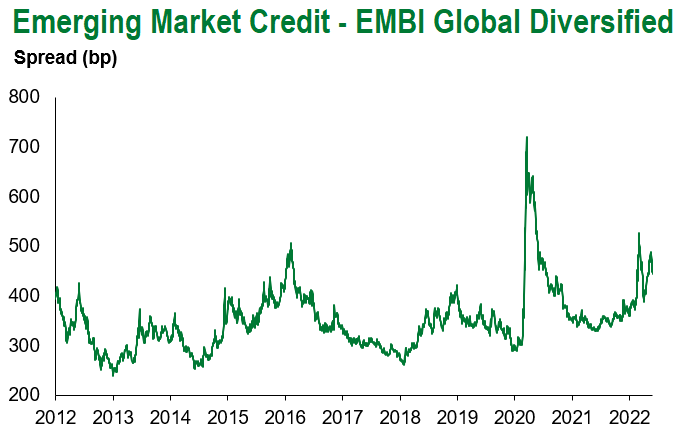
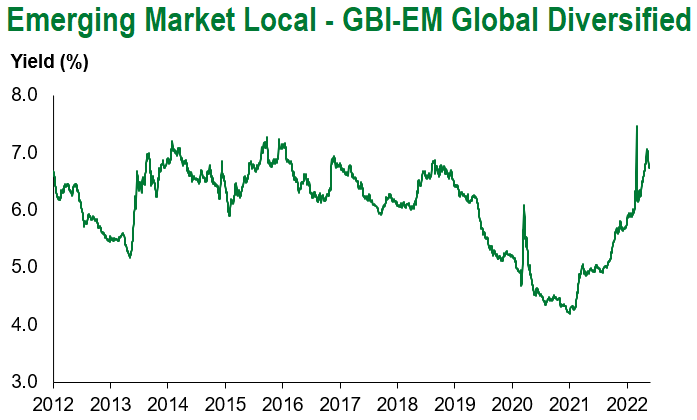
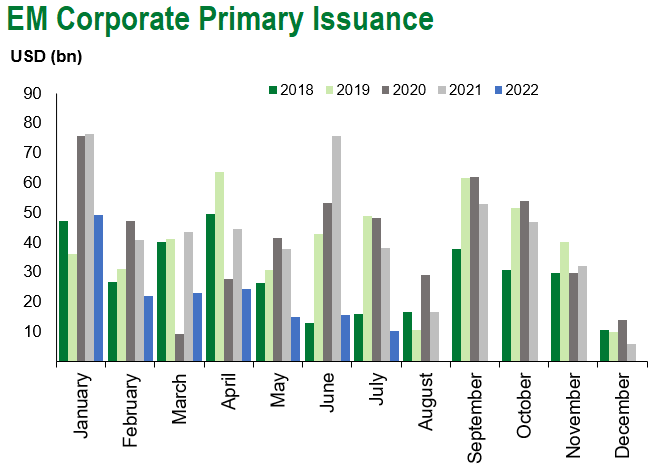
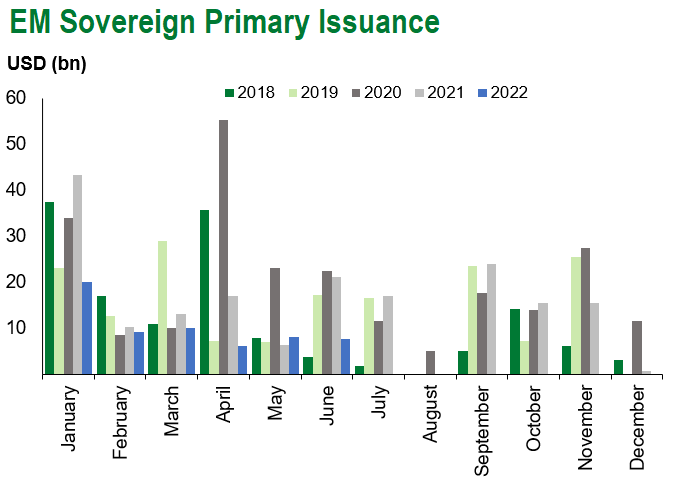
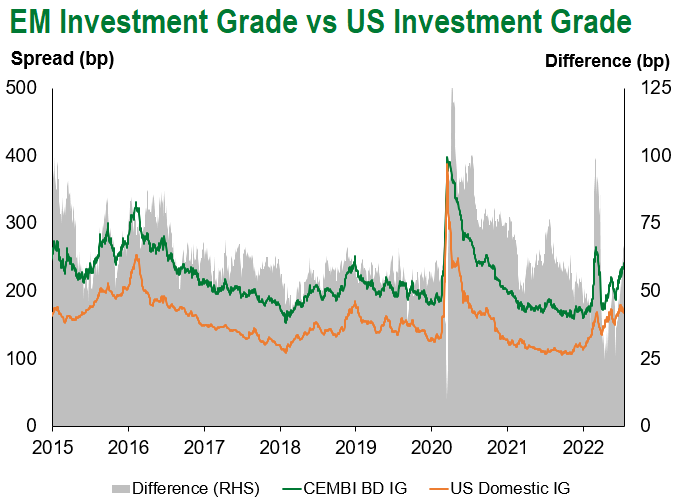
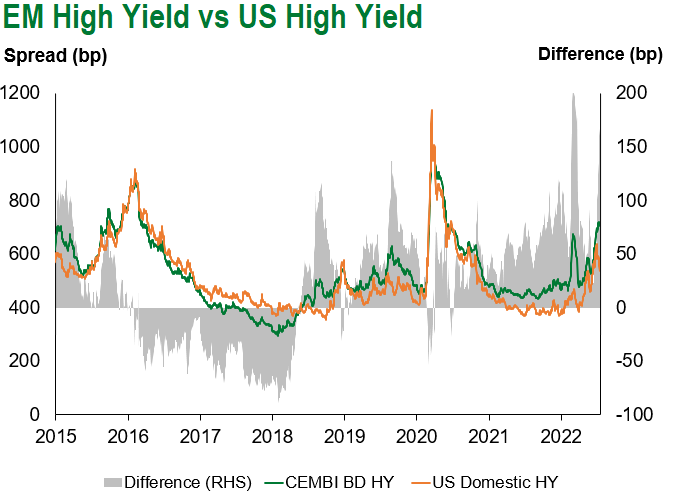
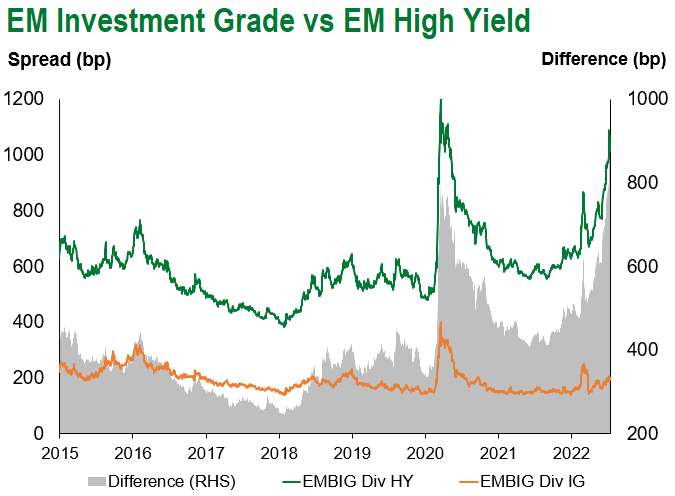
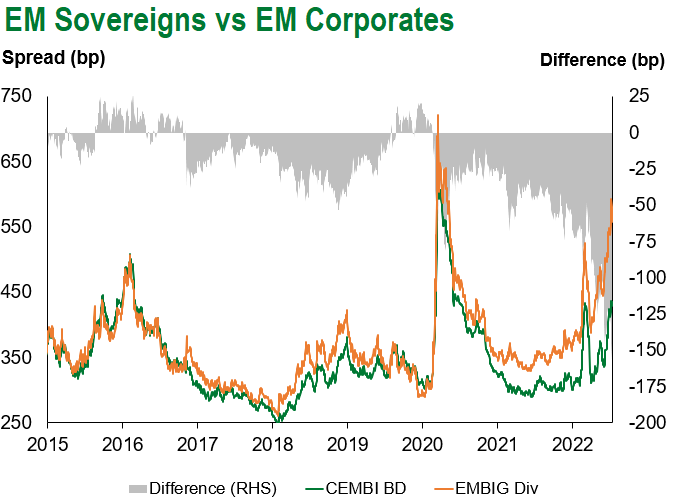
Emerging Markets Flows
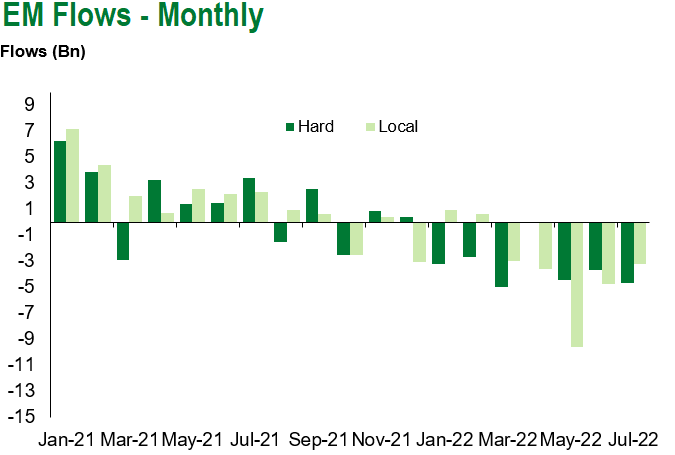
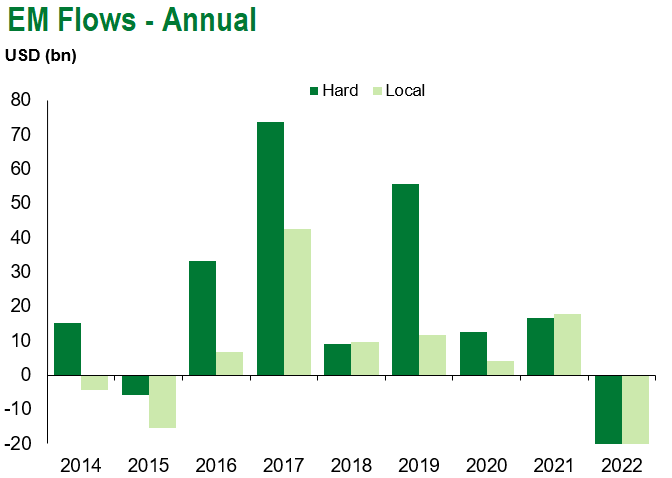
Source for graphs: Bloomberg, JPMorgan, Gramercy. As of July 22, 2022.
COVID Resources:
Johns Hopkins COVID-19 Case Tracker
For questions, please contact:
Kathryn Exum, CFA ESG, Director, Co-Head of Sovereign Research, [email protected]
Petar Atanasov, Director, Co-Head of Sovereign Research, [email protected]
James Barry, Director, Deputy Portfolio Manager, [email protected]
This document is for informational purposes only. The information presented is not intended to be relied upon as a forecast, research or investment advice, and is not a recommendation, offer or solicitation to buy or sell any securities or to adopt any investment strategy. Gramercy may have current investment positions in the securities or sovereigns mentioned above. The information and opinions contained in this paper are as of the date of initial publication, derived from proprietary and nonproprietary sources deemed by Gramercy to be reliable, are not necessarily all-inclusive and are not guaranteed as to accuracy. This paper may contain “forward-looking” information that is not purely historical in nature. Such information may include, among other things, projections and forecasts. There is no guarantee that any forecasts made will come to pass. Reliance upon information in this paper is at the sole discretion of the reader. You should not rely on this presentation as the basis upon which to make an investment decision. Investment involves risk. There can be no assurance that investment objectives will be achieved. Investors must be prepared to bear the risk of a total loss of their investment. These risks are often heightened for investments in emerging/developing markets or smaller capital markets. International investing involves risks, including risks related to foreign currency, limited liquidity, less government regulation, and the possibility of substantial volatility due to adverse political, economic or other developments. The information provided herein is neither tax nor legal advice. Investors should speak to their tax professional for specific information regarding their tax situation.
